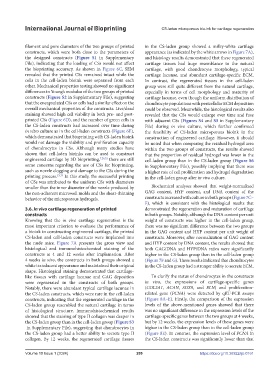Page 217 - IJB-10-1
P. 217
International Journal of Bioprinting CS-laden microporous bio-ink for cartilage regeneration
filament and pore diameters of the two groups of printed in the CS-laden group showed a milky-white cartilage
constructs, which were both close to the parameters of appearance (as indicated by the white arrows in Figure 7A),
the designed constructs (Figure S1 in Supplementary and histology results demonstrated that these regenerated
File), indicating that the loading of CSs would not affect cartilage tissues had huge resemblance to the natural
the bioprinting accuracy. As shown in Figure 6C, SEM cartilage, with good chondrocyte morphology, typical
revealed that the printed CSs remained intact while the cartilage lacunae, and abundant cartilage-specific ECM.
cells in the cell-laden bioink were separated from each In contrast, the regenerated tissues in the cell-laden
other. Mechanical properties testing showed no significant group were still quite different from the natural cartilage,
differences in Young’s modulus of the two groups of printed especially in terms of cell morphology and maturity of
constructs (Figure S2 in Supplementary File), suggesting cartilage lacunae, even though the uniform distribution of
that the encapsulated CSs or cells had a similar effect on the chondrocyte populations with pericellular ECM deposition
overall mechanical properties of the constructs. Live/dead could be observed. Meanwhile, the histological results also
staining showed high cell viability in both pre- and post- revealed that the CSs would enlarge over time and fuse
printed CSs (Figure 6D), and the number of green cells in with adjacent CSs (Figures S4 and S5 in Supplementary
the CS-laden constructs had increased over time during File) during in vivo culture, which further confirmed
in vitro culture as in the cell-laden constructs (Figure 6E), the feasibility of CS-laden microporous bioink in the
which demonstrated that bioprinting with CS-laden bioink construction of engineered cartilage. However, it should
would not damage the viability and proliferation capacity be noted that when comparing the residual hydrogel area
of chondrocytes in CSs. Although many studies have within the two groups of constructs, the results showed
shown that cell-laden bioinks can be used to construct that the proportion of residual hydrogel was lower in the
engineered cartilage by 3D bioprinting, 7,26,32 there are still cell-laden group than in the CS-laden group (Figure S6
some concerns regarding the use of CSs for bioprinting, in Supplementary File), possibly implying that there was
such as nozzle clogging and damage to the CSs during the a higher rate of cell proliferation and hydrogel degradation
printing process. 15,33 In this study, the successful printing in the cell-laden group after in vivo culture.
of CSs was attributed to the uniform CSs with diameters
smaller than the inner diameter of the nozzle produced by Biochemical analyses showed that weight-normalized
the non-adherent microwell molds and the shear-thinning GAG content, HYP content, and DNA content of the
behavior of the microporous hydrogels. constructs increased with culture in both groups (Figure 7C–
E), which is consistent with the histological results that
3.6. In vivo cartilage regeneration of printed demonstrated the regeneration and maturation of cartilage
constructs in both groups. Notably, although the DNA content per unit
Knowing that the in vivo cartilage regeneration is the weight of constructs was higher in the cell-laden group,
most important criterion to evaluate the performance of there was no significant difference between the two groups
a bioink in constructing engineered cartilage, the printed in the GAG content and HYP content per unit weight of
CS-laden and cell-laden constructs were implanted into constructs. Moreover, after normalization of GAG content
the nude mice. Figure 7A presents the gross view and and HYP content by DNA content, the results showed that
histological and immunohistochemical staining of the both GAG/DNA and HYP/DNA ratios were significantly
constructs at 4 and 12 weeks after implantation. After higher in the CS-laden group than in the cell-laden group
4 weeks in vivo, the constructs in both groups showed a (Figure 7F and G). These results indicated that chondrocytes
white translucent appearance and maintained their original in the CS-laden group had a stronger ability to secrete ECM.
shape. Histological staining demonstrated that cartilage-
like tissues with cartilage lacunae and GAG deposition To clarify the status of chondrocytes in the constructs
were regenerated in the constructs of both groups. in vivo, the expressions of cartilage-specific genes
Notably, there were abundant typical cartilage lacunae in (COL2A1, ACAN, SOX9, and ELN) and proliferation-
the CS-laden constructs, which were rare in the cell-laden related gene (PCNA) were detected by qRT-PCR assays
constructs, indicating that the regenerated cartilage in the (Figure 8A–E). Firstly, the comparison of the expression
CS-laden group resembled the natural cartilage in terms levels of the above-mentioned genes showed that there
of histological structure. Immunohistochemical results was no significant difference in the expression levels of the
showed that the staining of type II collagen was deeper in cartilage-specific genes between the two groups at 4 weeks,
the CS-laden group than in the cell-laden group (Figure S3 but by 12 weeks, the expression levels of these genes were
in Supplementary File), suggesting that chondrocytes in higher in the CS-laden group than in the cell-laden group
the CS-laden group had a better ability to secrete type II (Figure 8E). In contrast, the expression level of PCNA in
collagen. By 12 weeks, the regenerated cartilage tissues the CS-laden constructs was significantly lower than that
Volume 10 Issue 1 (2024) 209 https://doi.org/10.36922/ijb.0161

